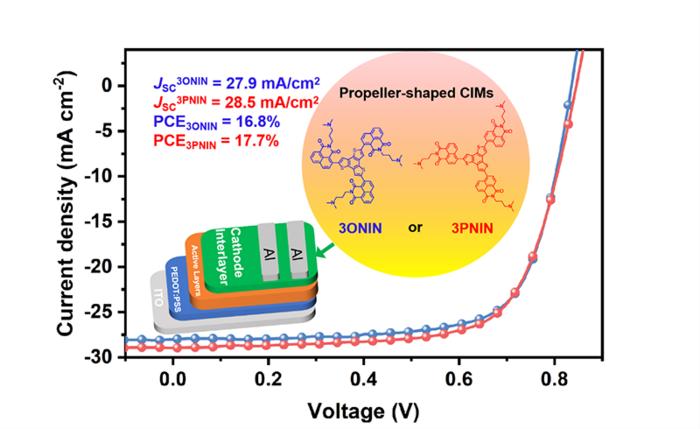Imagine technology as a race car speeding down a track – it can only go as fast as its engine allows. But just when it seemed like organic solar cells hit a roadblock, along comes 3PNIN, a game-changing molecule shaped like a propeller, ready to turbocharge their progress and break through barriers.

Credit: Minghua Huang, Ocean University of China
Imagine technology as a race car speeding down a track – it can only go as fast as its engine allows. But just when it seemed like organic solar cells hit a roadblock, along comes 3PNIN, a game-changing molecule shaped like a propeller, ready to turbocharge their progress and break through barriers.
Organic solar cells (OSCs) represent the pinnacle of renewable energy, yet certain components have fallen significantly behind the trajectory of ongoing development. Particularly, cathode interfacial materials (CIMs) have failed to sustain the momentum necessary to match the continuous enhancement of OSCs. CIMs play a critical role in facilitating current conduction from the metal to the semiconductor and vice versa; hence, if they fall short in electron-transport performance, the power conversion efficiency (PCE) of OSCs is compromised. In response to this challenge, researchers delved into investigating how molecular structure impacts the overall performance of both the cell and the interfacing materials. Two propeller-shaped compounds exemplify the significant influence that molecular configuration can exert on enhancing the functionality of CIMs and, consequently, the photovoltaic performance of OSCs.
Researchers published their results in Nano Research on February 6.
The study reported two isomers, 3PNIN and 3ONIN, which are molecules sharing the same formula but possessing distinct arrangements of end-capped groups. These varied group arrangements enable different intermolecular interactions to take place within one isomer that may not be achievable with the other.
“In the vast realm of renewable energy, OSCs have ascended to prominence, characterized by their ethereal architecture, semi-transparency, cost-effective production, and scalable printed assembly, heralding a new era in powering flexible wearable technologies,” remarked Prof. Minghua Huang, the author and researcher of the study.
The significance of this technology in a world where sustainable energy sources have gained considerable traction (and necessity) cannot be overstated. Upon testing the propeller-shaped isomers presented in this research, results revealed that the two compounds can exert vastly different effects based on their configuration, with one variant outperforming the other in enhancing the functionality of CIMs.
3PNIN exhibits a more planar molecular structure compared to its counterpart, 3ONIN. This structural disparity enables the end-capped groups in 3PNIN to lie flatter relative to 3ONIN, thereby demonstrating significant enhancements in functionality, such as electron mobility and conductivity. “As a result, 3PNIN and 3ONIN-treated OSC devices yield PCEs of 17.73% and 16.82%, respectively,” said Prof. Minghua Huang.
3PNIN displays significant promise in fabricating a thermally stable device while also enhancing PCE of OSCs, in addition to the benefits of improved mobility and conductivity compared to the prevailing technology widely utilized for CIMs. Further refinement of OSC devices treated with the 3PNIN isomer holds the potential to advance the accessibility and efficiency rates of this energy source. Enhancements in OSCs can exert a widespread impact on the renewable energy landscape and may extend to other realms of technology reliant on organic electronics.
Hao Liu, Jilei Jiang, Shuixing Dai, Xianbiao Hou, and Minghua Huang of the School of Materials Science and Engineering at the Ocean University of China, Liangmin Yu from the Open Studio for Marine Corrosion and Protection at the Pilot National Laboratory for Marine Science and Technology, Xu Zhang and Ke Gao of the Science Center for Material Creation and Energy Conversion at the Institute of Frontier and Interdisciplinary Science at Shandong University, and Heqing Jiang of the Qingdao Key Laboratory of Functional Membrane Material and Membrane Technology at the Chinese Academy of Sciences contributed to this research.
The National Natural Science Foundation of China (22105189) supported this research.
About Nano Research
Nano Research is a peer-reviewed, international and interdisciplinary research journal, publishes all aspects of nano science and technology, featured in rapid review and fast publishing, sponsored by Tsinghua University and the Chinese Chemical Society. It offers readers an attractive mix of authoritative and comprehensive reviews and original cutting-edge research papers. After 15 years of development, it has become one of the most influential academic journals in the nano field. In 2023 InCites Journal Citation Reports, Nano Research has an Impact Factor of 9.9, the total cites reached 35645, ranking first in China’s international academic journals, and the number of highly cited papers reached 229, ranked among the top 1.5% of 8786 academic journals.
About SciOpen
SciOpen is a professional open access resource for discovery of scientific and technical content published by the Tsinghua University Press and its publishing partners, providing the scholarly publishing community with innovative technology and market-leading capabilities. SciOpen provides end-to-end services across manuscript submission, peer review, content hosting, analytics, and identity management and expert advice to ensure each journal’s development by offering a range of options across all functions as Journal Layout, Production Services, Editorial Services, Marketing and Promotions, Online Functionality, etc. By digitalizing the publishing process, SciOpen widens the reach, deepens the impact, and accelerates the exchange of ideas.
Journal
Nano Research
DOI
10.1007/s12274-024-6482-z
Article Title
Propeller-shaped NI isomers of cathode interfacial material for efficient organic solar cells
Article Publication Date
6-Feb-2024




